2015 MERCEDES-BENZ E-CLASS ESTATE open bonnet
[x] Cancel search: open bonnetPage 314 of 497
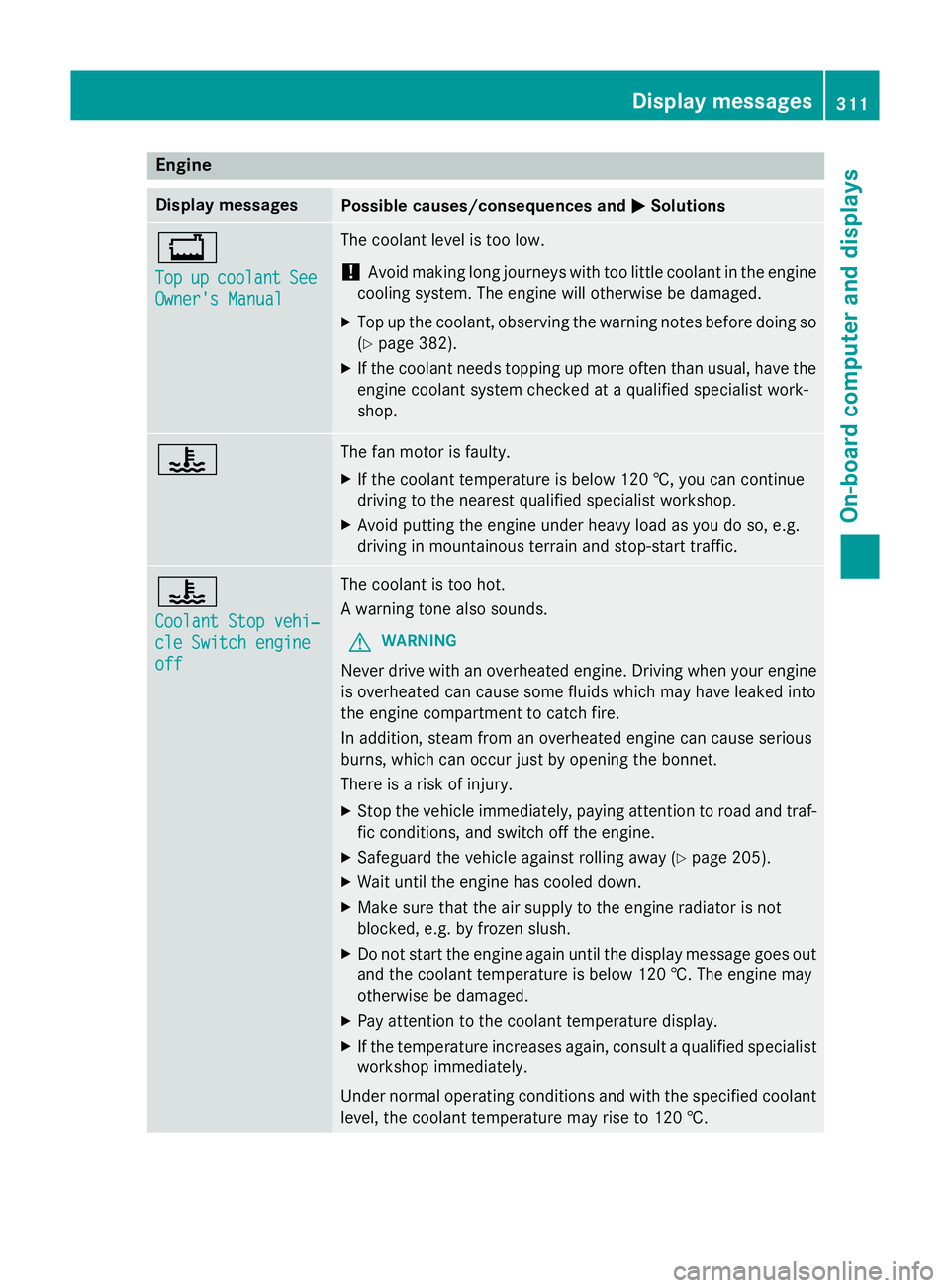
Engine
Display messages
Possible causes/consequences and
M
MSolutions +
Top Top
up
upcoolant
coolant See
See
Owner' sManual
Owner' sManual The coolant leve
listoolow.
! Avoid making lon
gjou rneys with to olittle coolant in th eengine
cooling system. The engin ewill otherwise be damaged.
X Top up th ecoolant ,observing th ewarning note sbefore doin gso
( Y page 382).
X If th ecoolant needs toppin gupmoreo ften than usual, have the
engin ecoolant system checked at aqualifie dspecialist work-
shop. ? The fan motor is faulty.
X If th ecoolant temperatur eisbelow 12 0†,you can continue
driving to th eneares tqualifie dspecialist workshop.
X Avoid putting th eengineu nde rheav yload as you do so, e.g.
driving in mountainous terrain and stop-start traffic. ?
Coolan
tStopv ehi‐
Coolan tStopv ehi‐
cle Switch engine cle Switch engine
off off The coolant is to
ohot.
Aw arning tone also sounds.
G WARNING
Never driv ewith an overheate dengine. Drivin gwhen your engine
is overheate dcan caus esom efluids whic hmay have leaked into
th ee nginec ompartmen ttocatch fire.
In addition ,steam from an overheate denginec an caus eserious
burns, whic hcan occur jus tbyopening th ebonnet.
Ther eisar isk of injury.
X Stop th evehicle immediately, paying attentio ntoroad and traf-
fic conditions, and switch off th eengine.
X Safeguard th evehicle against rolling away (Y page 205).
X Wait until th eengineh as cooled down.
X Mak esure that th eair supply to th eenginer adiator is not
blocked, e.g .byfrozenslush.
X Do no tstart th eenginea gain until th edisplay message goes out
and th ecoolant temperatur eisbelow 12 0†.The engin emay
otherwise be damaged.
X Pay attentio ntothecoolant temperatur edisplay.
X If th etem peratur eincreases again ,consult aqualifie dspecialist
workshop immediately.
Under normal operatin gcondition sand with th especified coolant
level, th ecoolant temperatur emay rise to 12 0†. Displa
ymessages
311On-boardcomputer and displays Z
Page 329 of 497
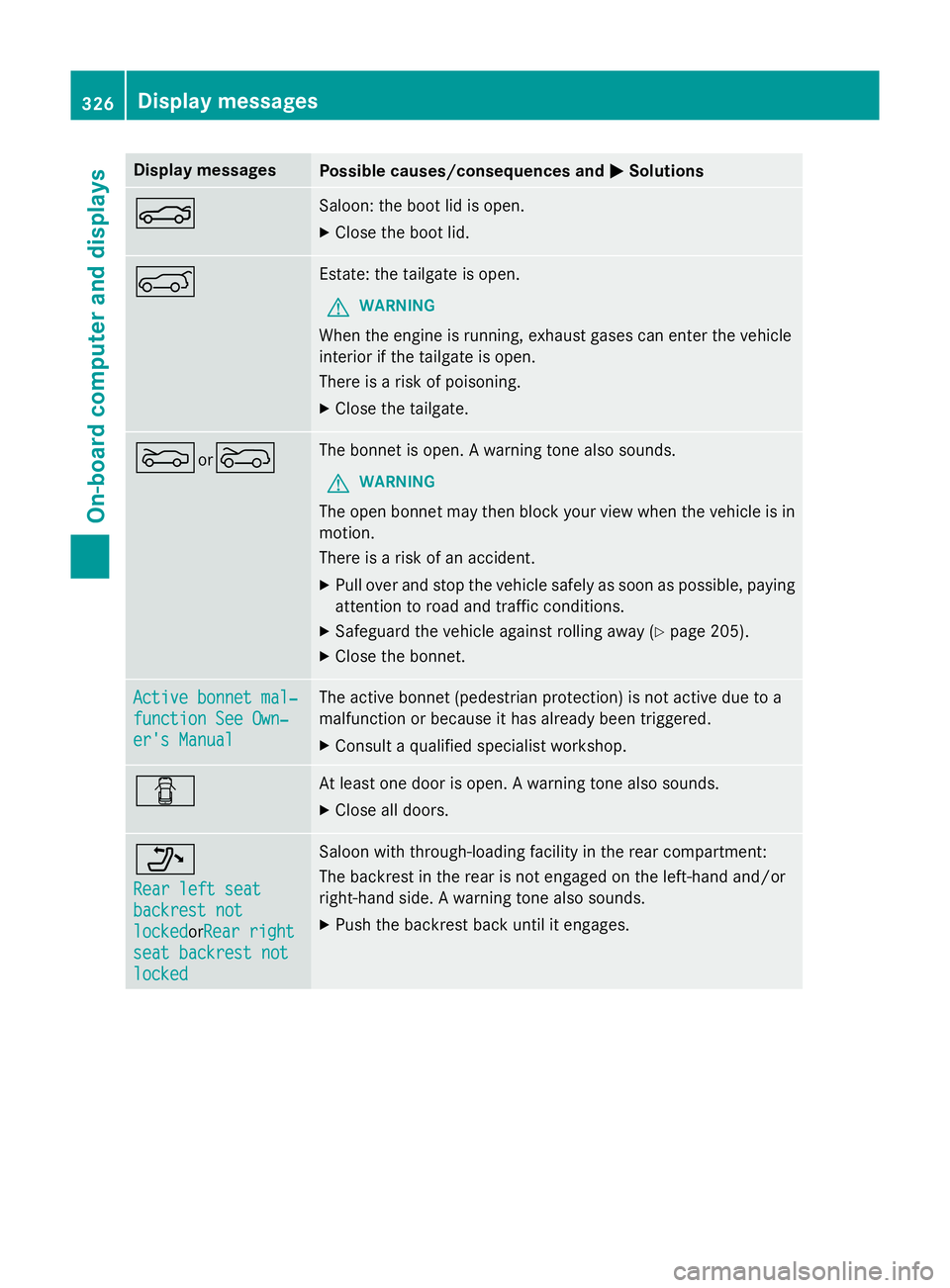
Display messages
Possible causes/consequences and
M
MSolutions N Saloon
:the boo tlid is open.
X Clos ethe boo tlid. A Estate: th
etailgat eisopen.
G WARNING
Whe nthe engin eisrunning ,exhaus tgase scan ente rthe vehicle
interio rifthetailgat eisopen.
There is ariskofp oisoning.
X Clos ethe tailgate. Mor
? The bonne
tisopen.Aw arnin gtonea lso sounds.
G WARNING
The open bonne tmay then bloc kyour vie wwhen th evehicl eisin
motion.
There is ariskofana ccident.
X Pull ove rand stop th evehicl esafely as soo naspossible, paying
attention to roa dand traffic conditions.
X Safeguar dthe vehicl eagainst rollin gaway (Y page 205).
X Clos ethe bonnet. Active bonnet mal‐ Active bonnet mal‐
function See Own‐ function See Own‐
er'
sM anual
er' sM anual The active bonne
t(pedestrian protection )isnotactive due to a
malfunction or because it has already been triggered.
X Consult aqualified specialist workshop. C At leas
tone doo riso pen.Aw arnin gtonea lso sounds.
X Clos eall doors. _
Rea
rl efts eat
Rea rl efts eat
backrest not backrest not
locked locked orRear right
Rea rr ight
sea tb ackrest not
sea tb ackrest not
locked
locked Saloon wit
hthrough-loading facilit yint he rear compartment:
The backrest in th erear is no tengage dont heleft-han dand/or
right-hand side .Awarnin gtonea lso sounds.
X Push th ebackrest bac kuntil it engages. 326
Display
messagesOn-boardcomputer an ddisplays
Page 340 of 497
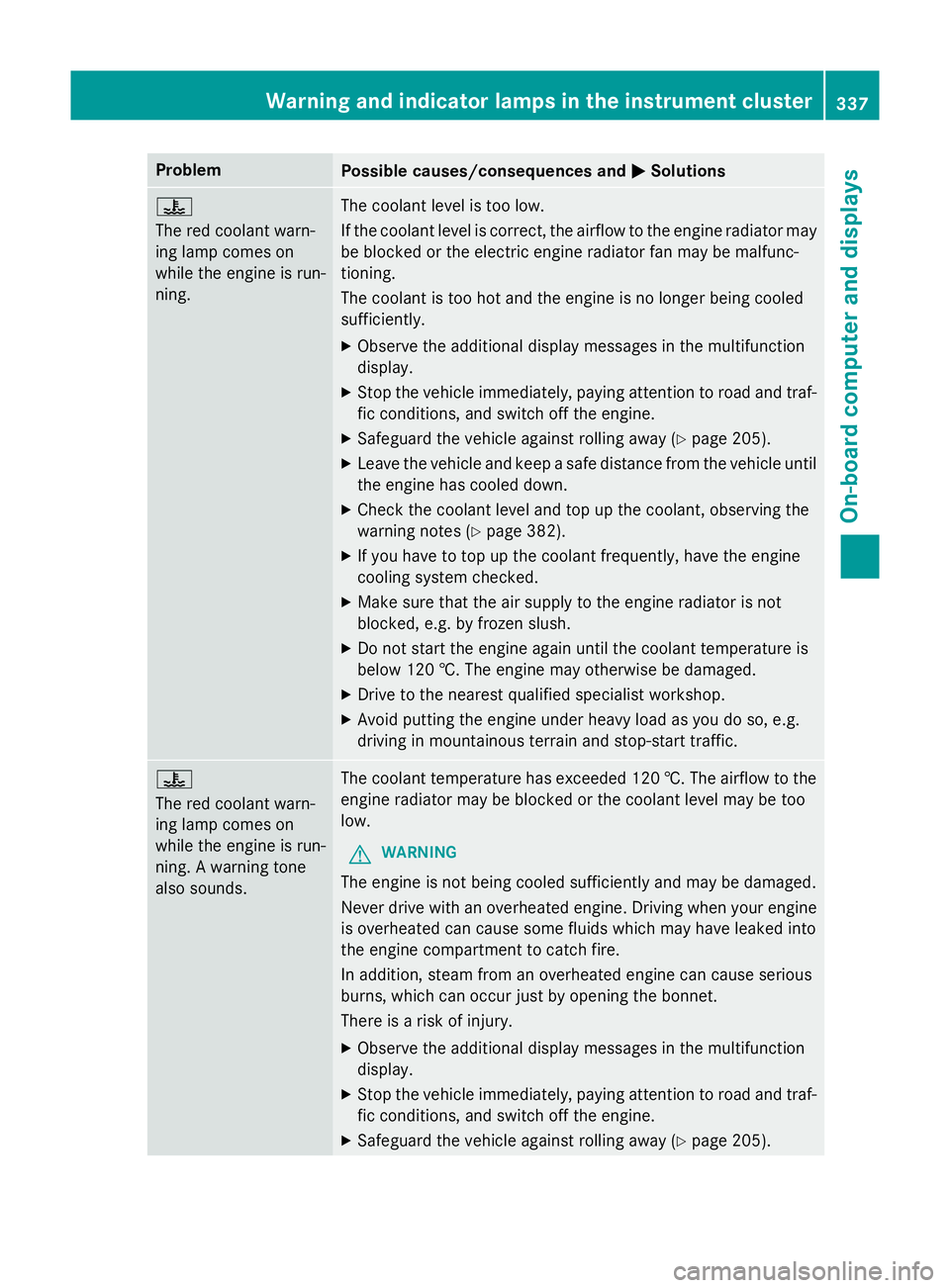
Problem
Possible causes/consequences and
M
MSolutions ?
The red coolant warn-
ing lamp comes on
while the engine is run-
ning.
The coolant level is too low.
If the coolant level is correct,t
he airflow to the engine radiator may
be blocked or the electric engine radiator fan may be malfunc-
tioning.
The coolant is too hot and the engine is no longer being cooled
sufficiently.
X Observe the additional display messages in the multifunction
display.
X Stop the vehicle immediately, paying attention to road and traf-
fic conditions, and switch off the engine.
X Safeguard the vehicle against rolling away (Y page 205).
X Leave the vehicle and keep asafe distance from the vehicle until
the engine has cooled down.
X Check the coolant level and top up the coolant, observing the
warning notes (Y page 382).
X If you have to top up the coolant frequently, have the engine
cooling system checked.
X Make sure that the air supply to the engine radiator is not
blocked, e.g. by frozen slush.
X Do not start the engine again until the coolant temperature is
below 120 †. The engine may otherwise be damaged.
X Drive to the nearest qualified specialist workshop.
X Avoid putting the engine under heavy load as you do so, e.g.
driving in mountainous terrain and stop-start traffic. ?
The red coolant warn-
ing lamp comes on
while the engine is run-
ning.
Awarning tone
also sounds. The coolant temperature has exceeded 120 †. The airflow to the
engine radiator may be blocked or the coolant level may be too
low.
G WARNING
The engine is not being cooled sufficiently and may be damaged.
Never drive with an overheated engine. Driving when your engine is overheated can cause some fluids which may have leaked into
the engine compartmen ttocatch fire.
In addition, steam from an overheated engine can cause serious
burns, which can occur just by opening the bonnet.
There is arisk of injury.
X Observe the additional display messages in the multifunction
display.
X Stop the vehicle immediately, paying attention to road and traf-
fic conditions, and switch off the engine.
X Safeguard the vehicle against rolling away (Y page 205).Warning and indicator lampsint
he instrument cluster
337On-board computer and displays Z
Page 381 of 497
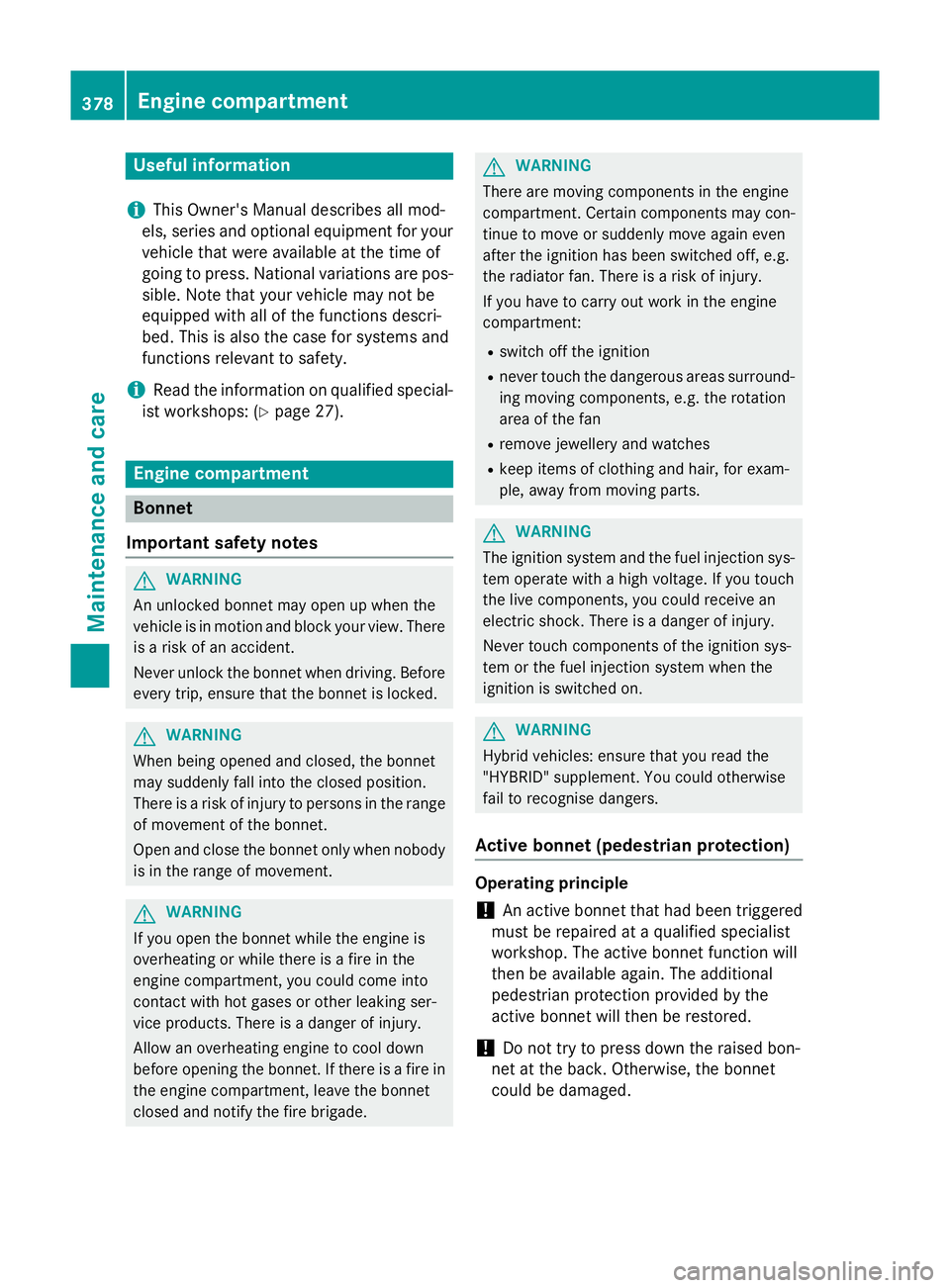
Useful information
i This Owner's Manual describes all mod-
els, series and optional equipment for your
vehicle that were available at the time of
going to press. National variation sare pos-
sible. Not ethat your vehicle may not be
equipped with all of the function sdescri-
bed. This is also the case for system sand
function srelevan ttosafety.
i Read the information on qualified special-
ist workshops: (Y page 27). Engine compartment
Bonnet
Important safet ynotes G
WARNING
An unlocked bonnet may open up when the
vehicle is in motion and block your view. There is ar isk of an accident.
Never unlock the bonnet when driving. Before
every trip, ensure that the bonnet is locked. G
WARNING
When being opened and closed, the bonnet
may suddenly fall int othe closed position.
There is arisk of injury to person sinthe range
of movement of the bonnet.
Open and close the bonnet only when nobody
is in the range of movement. G
WARNING
If you open the bonnet while the engin eis
overheating or while ther eisafire in the
engin ecompartment, you could come into
contact with hot gases or other leaking ser-
vice products. There is adanger of injury.
Allow an overheating engin etocool down
before openin gthe bonnet. If ther eisafire in
the engin ecompartment, leave the bonnet
closed and notify the fire brigade. G
WARNING
There are movin gcomponents in the engine
compartment. Certain components may con-
tinue to move or suddenly move again even
after the ignition has been switched off, e.g.
the radiator fan. There is arisk of injury.
If you have to carry out work in the engine
compartment:
R switc hoff the ignition
R neve rtouc hthe dangerous areas surround-
ing movin gcomponents, e.g. the rotation
area of the fan
R remov ejewellery and watches
R keep items of clothing and hair, for exam-
ple, away from movin gparts. G
WARNING
The ignition system and the fuel injection sys- tem operate with ahigh voltage. If you touch
the live components, you could receiv ean
electric shock .There is adanger of injury.
Never touc hcomponents of the ignition sys-
tem or the fuel injection system when the
ignition is switched on. G
WARNING
Hybrid vehicles :ensure that you read the
"HYBRID "supplement .You could otherwise
fail to recognise dangers.
Active bonnet (pedestria nprotection) Operating principle
! An activ
ebonnet that had been triggered
must be repaired at aqualified specialist
workshop. The activ ebonnet function will
then be available again. The additional
pedestrian protection provided by the
activ ebonnet will then be restored.
! Do not try to press down the raised bon-
net at the back. Otherwise, the bonnet
could be damaged. 378
Engine compartmentMaintenance and care
Page 382 of 497
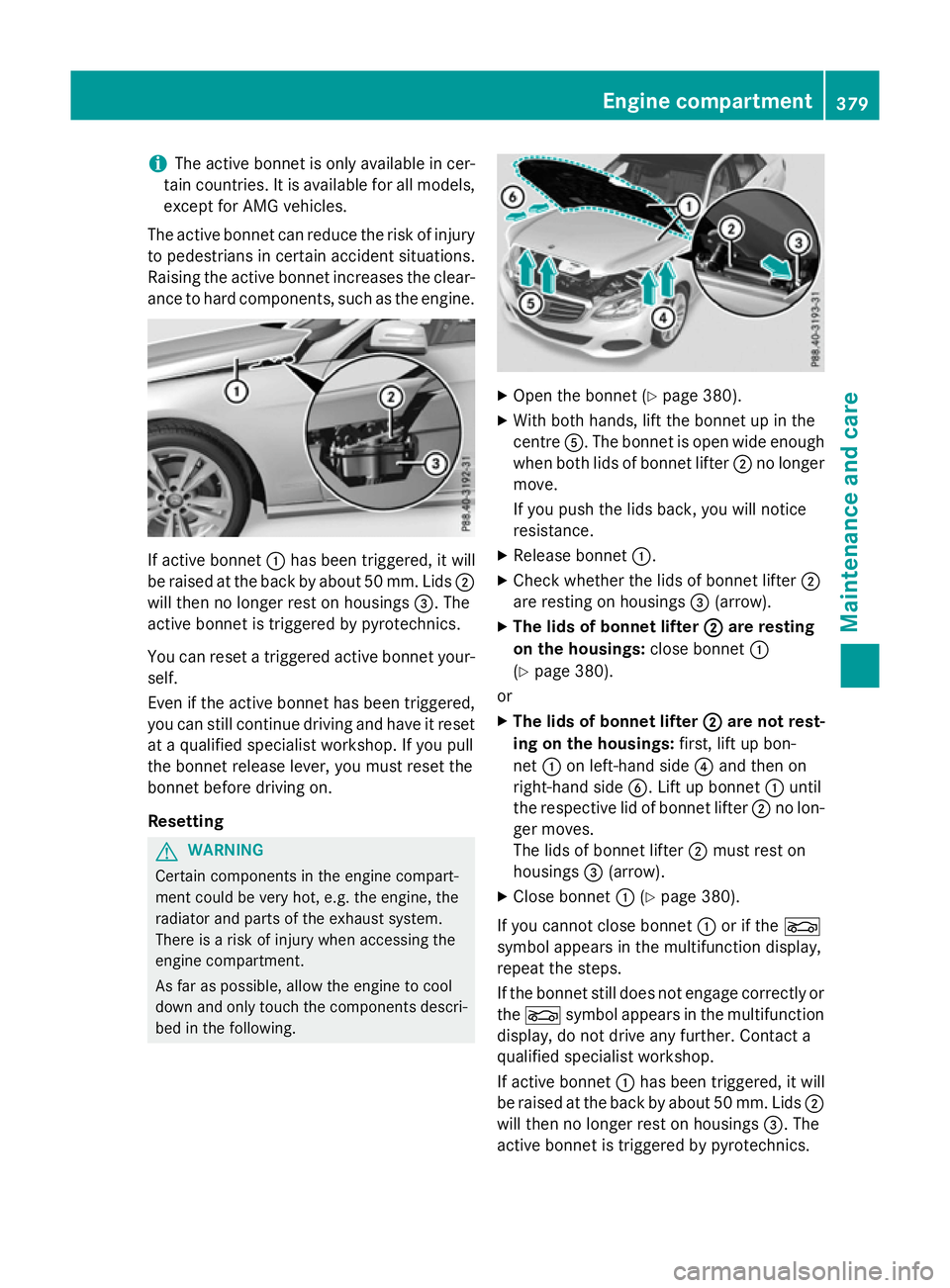
i
The active bonnet is only available in cer-
tain countries. It is available for all models,
except for AMG vehicles.
The active bonnet can reduce the risk of injury to pedestrians in certain accident situations.
Raising the active bonnet increases the clear-
ance to hard components, such as the engine. If active bonnet
:has been triggered, it will
be raised at the back by about 50 mm. Lids ;
will then no longer rest on housings =.The
active bonnet is triggered by pyrotechnics.
You can reset atriggered active bonnet your-
self.
Even if the active bonnet has been triggered,
you can still continue driving and have it reset
at aq ualified specialist workshop. If you pull
the bonnet release lever, you must reset the
bonnet before driving on.
Resetting G
WARNING
Certain components in the engine compart-
ment could be very hot, e.g. the engine, the
radiator and parts of the exhaust system.
There is arisk of injury when accessing the
engine compartment.
As far as possible, allow the engine to cool
down and only touch the components descri- bed in the following. X
Open the bonnet (Y page 380).
X With both hands, lift the bonnet up in the
centre A.The bonnet is open wide enough
when both lids of bonnet lifter ;no longer
move.
If you push the lids back, you will notice
resistance.
X Release bonnet :.
X Check whether the lids of bonnet lifter ;
are restin gonhousings =(arrow).
X The lids of bonnet lifter ; ;are resting
on the housings: close bonnet:
(Y page 380).
or
X The lids of bonnet lifter ;
;are not rest-
ing on the housings: first, lift up bon-
net :on left-hand side ?and then on
right-hand side B.Lift up bonnet :until
the respective lid of bonnet lifter ;no lon-
ger moves.
The lids of bonnet lifter ;must rest on
housings =(arrow).
X Close bonnet :(Ypage 380).
If you cannot close bonnet :or if the L
symbol appears in the multifunction display,
repeat the steps.
If the bonnet still does not engage correctly or
the L symbol appears in the multifunction
display ,donot drive any further .Contact a
qualified specialist workshop.
If active bonnet :has been triggered, it will
be raised at the back by about 50 mm. Lids ;
will then no longer rest on housings =.The
active bonnet is triggered by pyrotechnics. Engine compartment
379Maintenance and care Z
Page 383 of 497
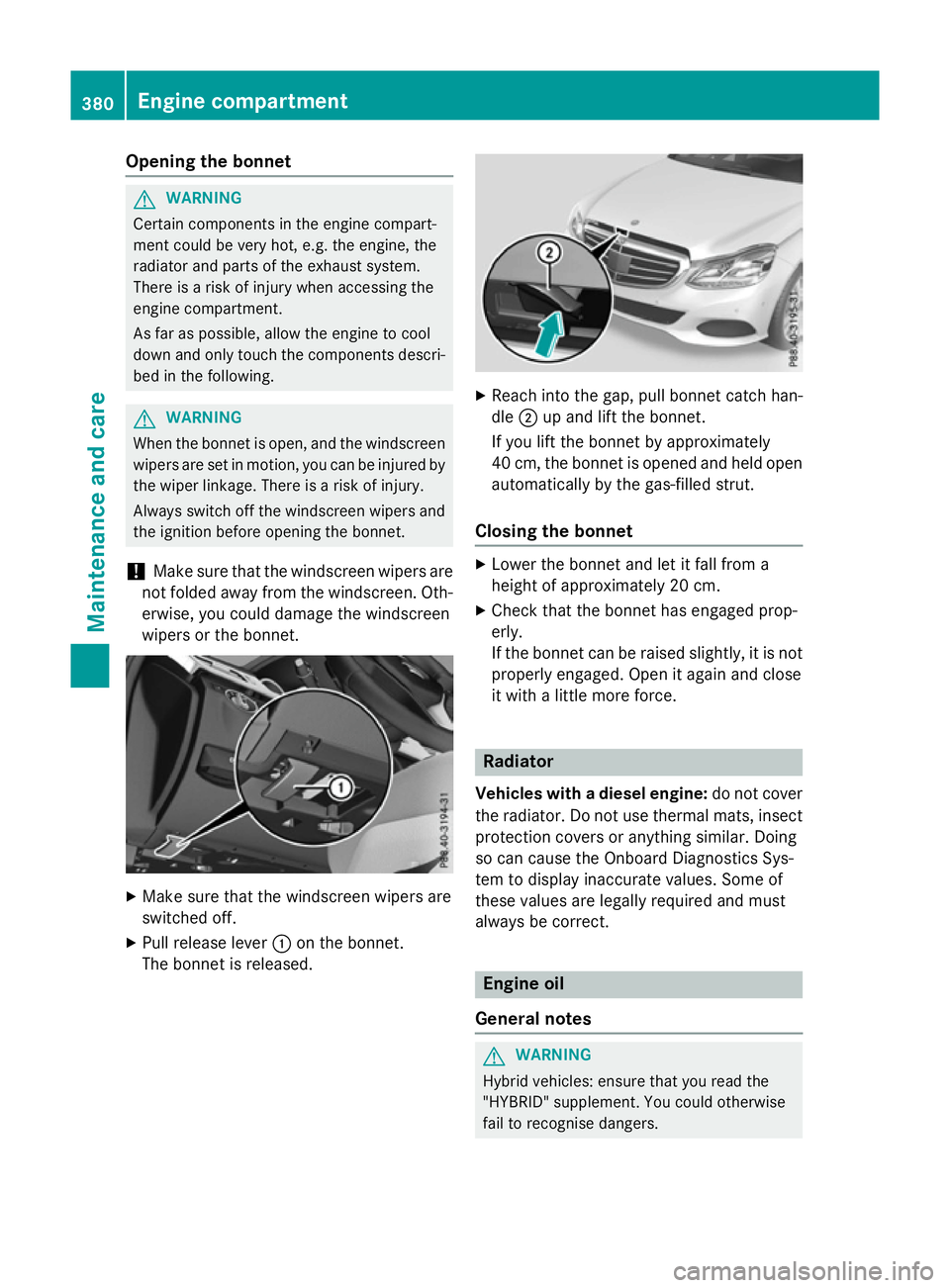
Opening the bonnet
G
WARNING
Certain componentsint he engine compart-
ment could be very hot, e.g. the engine, the
radiator and parts of the exhaust system.
There is arisk of injur ywhen accessin gthe
engin ecompartment.
As far as possible, allow the engine to cool
down and only touch the componentsd escri-
bed in the following. G
WARNING
When the bonnet is open, and the windscreen wipers are set in motion ,you can be injured by
the wiper linkage. There is arisk of injury.
Always switch off the windscreen wipers and
the ignition before opening the bonnet.
! Make sure that the windscreen wipers are
not folded away from the windscreen. Oth-
erwise, you could damage the windscreen
wipers or the bonnet. X
Make sure that the windscreen wipers are
switched off.
X Pull release lever :on the bonnet.
The bonnet is released. X
Reach intot he gap, pull bonnet catc hhan-
dle ;up and lift the bonnet.
If you lift the bonnet by approximately
40 cm, the bonnet is opened and held open automatically by the gas-filled strut.
Closing the bonnet X
Lower the bonnet and let it fall from a
height of approximately 20 cm.
X Check that the bonnet has engaged prop-
erly.
If the bonnet can be raised slightly, it is not
properly engaged. Open it again and close
it with alittle more force. Radiator
Vehicles with adiesel engine: do not cover
the radiator. Do not use thermal mats, insect
protection cover soranythin gsimilar. Doing
so can cause the Onboard Diagnostics Sys-
tem to display inaccurate values. Some of
these values are legally required and must
alway sbec orrect. Engine oil
General notes G
WARNING
Hybrid vehicles: ensure that you read the
"HYBRID "supplement .You could otherwise
fail to recognise dangers. 380
Engine compartmentMaintenance and care
Page 407 of 497
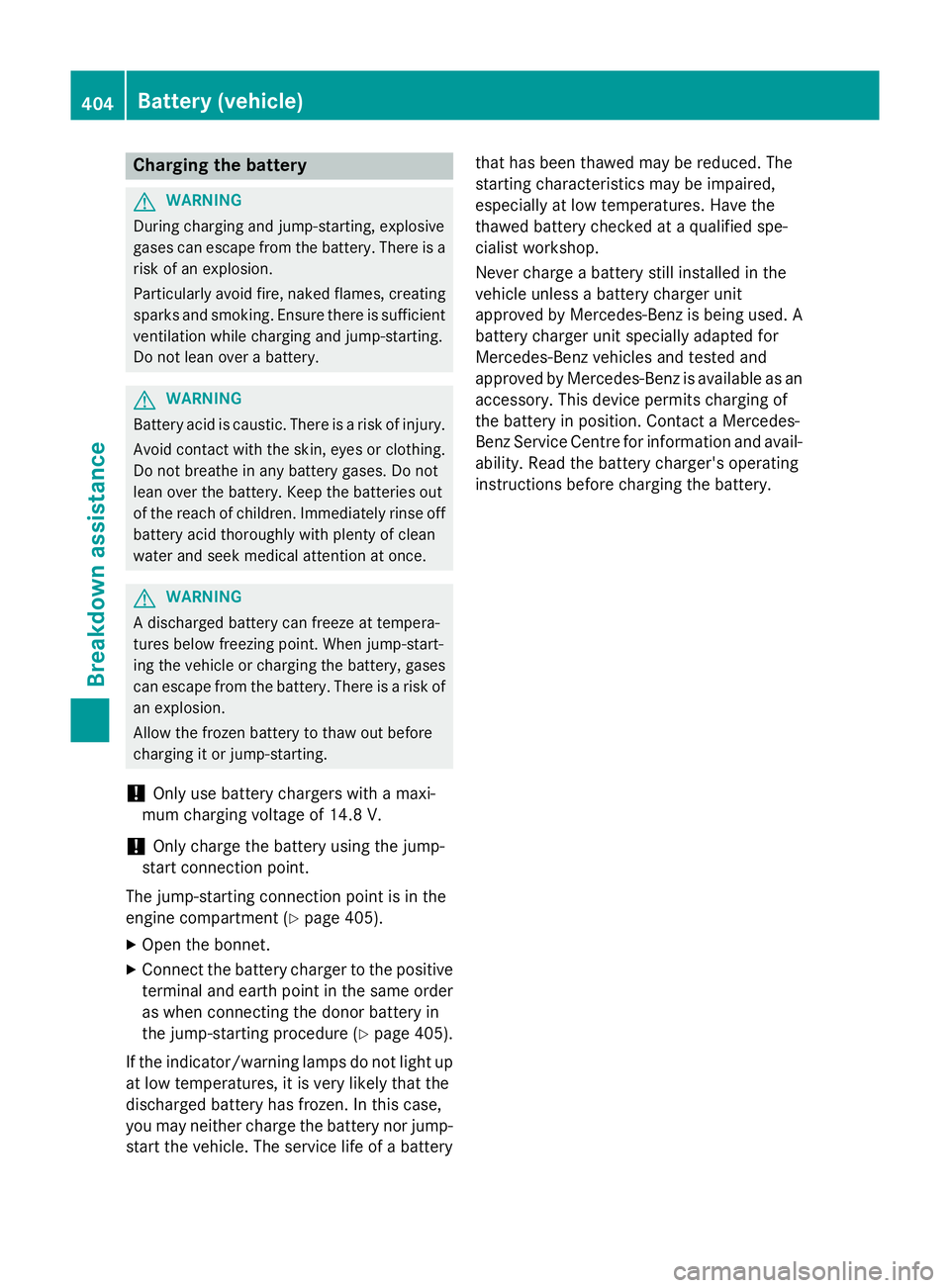
Charging th
ebattery G
WARNING
During chargin gand jump-starting, explosive
gases can escape from th ebattery. Ther eisa
ris kofane xplosion.
Particularly avoid fire, naked flames, creating
sparks and smoking. Ensure there is sufficient
ventilatio nwhile chargin gand jump-starting.
Do no tlean ove rabattery. G
WARNING
Battery acid is caustic .Ther eisar iskofi njury.
Avoid contac twitht he skin, eyes or clothing.
Do no tbreath eina ny battery gases .Donot
lean ove rthe battery. Keep th ebatteries out
of th ereac hofc hildren. Immediately rinse off
battery acid thoroughly wit hplenty of clean
wate rand seek medical attentio natonce. G
WARNING
Ad ischarged battery can freez eattempera-
tures below freezing point. When jump-start-
ing th evehicle or chargin gthe battery, gases
can escape from th ebattery. Ther eisariskof
an explosion.
Allow th efroze nbattery to thaw out before
chargin gitorjump-starting.
! Only use battery chargers wit
hamaxi-
mum chargin gvoltage of 14.8 V.
! Only charge th
ebattery usin gthe jump-
start connection point.
The jump-startin gconnectio npointisint he
engin ecom partmen t(Ypage 405).
X Open th ebonnet.
X Connect th ebattery charge rtothepositive
terminal and eart hpointint hesame order
as when connecting th edonor battery in
th ej ump-startin gprocedure (Y page 405).
If th eindicator/warning lamps do no tlight up
at low temperatures, it is ver ylikely that the
discharged battery has frozen .Inthisc ase,
you may neither charge th ebattery no rjump-
start th evehicle .The servic elife of abattery that has been thawed may be reduced. The
starting characteristic smay be impaired,
especiall yatlow temperatures. Hav ethe
thawed battery checked at aqualified spe-
cialist workshop.
Never charge abattery still installed in the
vehicle unless abattery charge runit
approved by Mercedes-Ben zisbeingu sed. A
battery charge runit specially adapted for
Mercedes-Ben zvehicle sand tested and
approved by Mercedes-Ben zisavailabl easan
accessory. This device permits chargin gof
th eb attery in position. Contac taMercedes-
Ben zServic eCentr efor informatio nand avail-
ability. Read th ebattery charger's operating
instruction sbefore chargin gthe battery. 404
Battery (vehicle)Breakdown assistance
Page 409 of 497
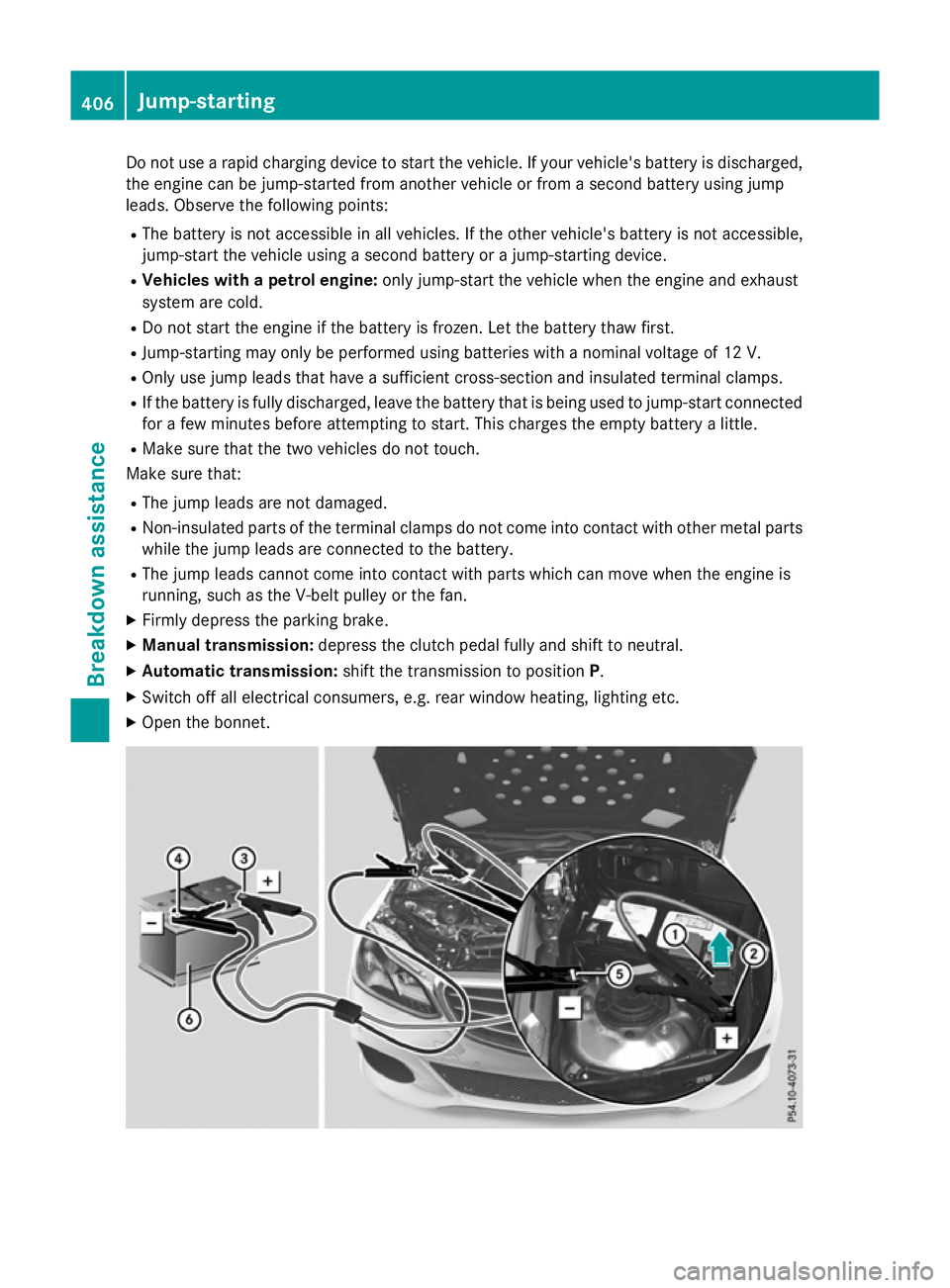
Do not us
earapid charging device to start the vehicle. If your vehicle' sbattery is discharged,
the engine can be jump-started fro manothe rvehicl eorf romas econd battery using jump
leads. Observe the following points:
R Th eb attery is not accessibl einallvehicles .Ifthe other vehicle' sbattery is not accessible,
jump-star tthe vehicl eusing asecond battery or ajump-starting device.
R Vehicle swithap etrolengine: onlyjump-star tthe vehicl ewhent he engine and exhaust
syste marecold.
R Do not start the engine if the battery is frozen. Let the battery tha wfirst.
R Jump-starting ma yonlybep erforme dusing batteries with anominal voltag eof12V.
R Onl yusejum pleads thathaveas ufficient cross-sectio nand insulate dtermina lclamps.
R If the battery is full ydischarged, leav ethe battery tha tisb eing used to jump-star tconnected
for afew minute sbefor ea ttempting to start. This charge sthe empty battery alittle.
R Make sure tha tthe two vehicles do not touch.
Make sure that:
R Th ej um pleads aren ot damaged.
R Non-insulate dparts of the termina lclamps do not come into contact with other meta lparts
whil ethe jum pleads arec onnected to the battery.
R Th ej um pleads cannot come into contact with parts which can mov ewhent he engine is
running ,suc hast he V-bel tpulle yort he fan.
X Firml ydepress the parking brake.
X Manual transmission: depress the clutch peda lfully and shift to neutral.
X Automatic transmission: shift the transmission to position P.
X Switch off al lelectrica lconsumers ,e.g.r ea rw indo wh eating, lighting etc.
X Open the bonnet. 406
Jump-startingBreakdow
nassistance